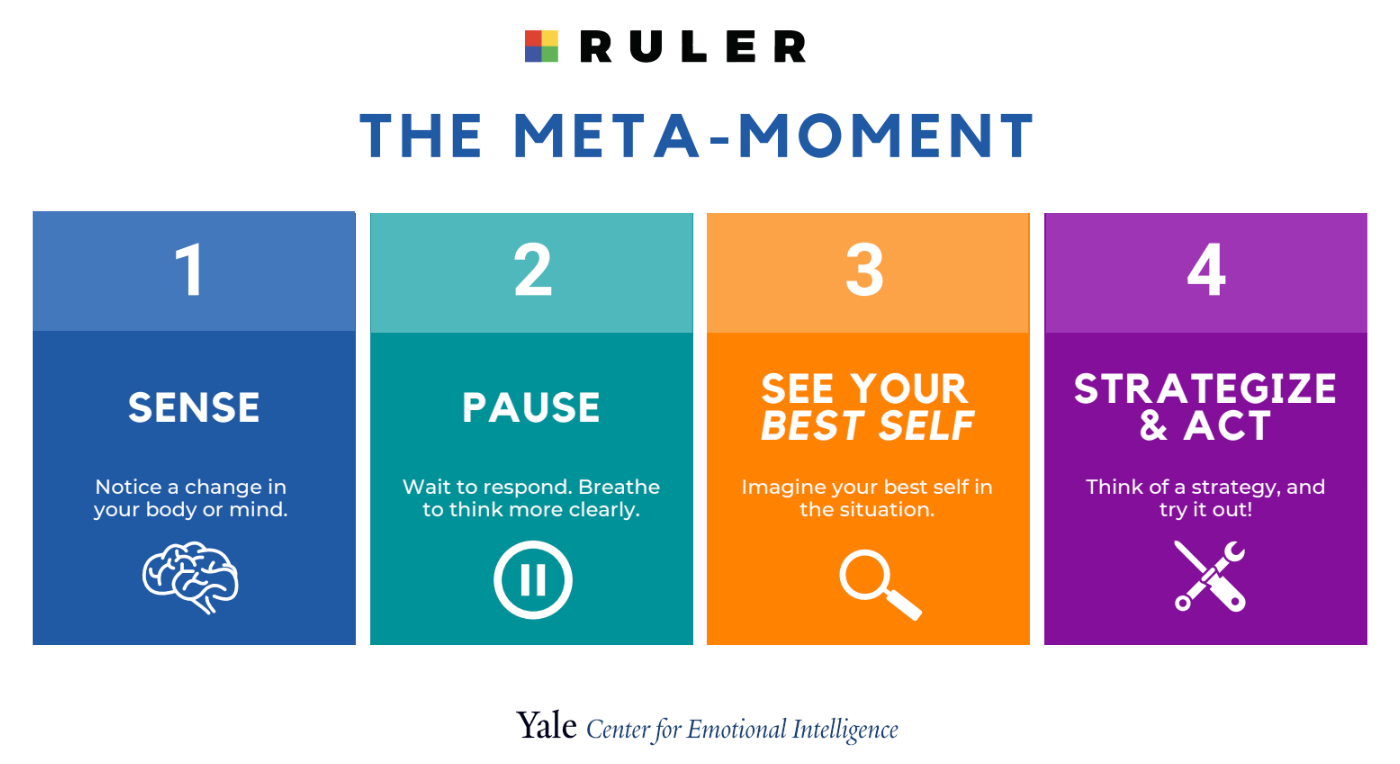Meta Moment: Harnessing the Space Between Stimulus and Response to Take Back Your Power

Meta Moment: Harnessing the Space Between Stimulus and Response to Take Back Your Power
In the whirlwind of daily life - parenting, work, relationships, and the constant stream of external stimuli - we all encounter moments that test our emotional limits. Whether it’s a sharp comment from a loved one, a stressful deadline, or a child’s meltdown at the end of a long day, these moments can trigger powerful emotional responses. And while emotions are essential to the human experience, how we respond to them can either deepen our relationships or damage them.
The Meta-Moment is a simple yet transformative emotional regulation tool that empowers us to pause, breathe, reflect, and choose a response that aligns with our best self. Developed by the Yale Center for Emotional Intelligence (YCEI) as part of its RULER framework, the Meta-Moment offers a structured way to move from reactivity to intentionality—especially in emotionally charged situations.
Why Emotions Matter
Emotions evolved with us for a reason. They help us learn, stay safe, and build meaningful connections. Fear alerts us to danger. Joy reinforces positive experiences. Sadness helps us process loss. Anger can signal injustice. But while emotions are vital, they can also be overwhelming, especially when triggered by those closest to us.
Most of us have experienced moments where we react in ways we later regret: yelling, shutting down, saying something hurtful, or withdrawing. These reactions can sometimes offer temporary gratification but often stem from unregulated emotions. And while we may have developed coping mechanisms over time, true emotional regulation is a learned skill—one that requires tools, practice, and intention.
Understanding and regulating our emotions lays the foundation for wiser choices, deeper relationships, and a more grounded sense of self. The Meta-Moment is one of the most effective tools for cultivating emotional intelligence.
What Is the Meta-Moment?
The Meta-Moment is the space between stimulus and response—the moment when you get to choose how you want to respond: either automatically and reactively, or with intention and thoughtfulness. We can also use this tool proactively. For example, imagine you're about to give a speech in front of a large audience and feel your nerves taking over. In that moment, you can use a Meta-Moment to pause and envision how your best self would handle the situation—calm, confident, and in control.
The Meta-Moment is a core strategy within RULER, the Yale Center for Emotional Intelligence’s evidence-based approach to teaching emotional intelligence in schools and communities. RULER stands for Recognizing, Understanding, Labeling, Expressing, and Regulating emotions. The Meta-Moment specifically supports the regulation component by helping individuals pause between a trigger and their response. This pause is powerful. It activates the parasympathetic nervous system, which lowers stress hormones like cortisol and helps regulate emotional intensity. It also creates space for reflection, allowing us to choose actions that reflect our values rather than our impulses.
The Four Steps of the Meta-Moment

The Meta-Moment process includes four steps that guide us from emotional activation to thoughtful response:
We all experience situations when something happens (real or imagined) that sparks an emotional reaction. It could be a comment, a look, a tone, or even a memory. The first step is noticing that shift.
1. Sense the Emotional Response
Pay attention to how the trigger affects your body and mind. Are your thoughts racing? Is your heart pounding? Are your fists clenched or your voice tightening? Can you feel your habitual ways of dealing with your feelings rising to the surface? These physical and cognitive cues signal that you’re activated, which is your cue to take a Meta-Moment.
2. Stop and Breathe
This is the heart of the Meta-Moment: pause, take a few deep breaths, and repeat a calming mantra. This simple act can help deactivate the emotional charge and create space to choose a more intentional path forward.
If time allows, try to identify the emotion you're feeling.
3. See Your Best Self
Visualize who you want to be in this moment. What qualities do you embody when you’re at your best: compassionate, thoughtful, courageous, patient? How can I respond in a way that aligns with my values and goals?
Ask yourself:
- Who do I want to be right now?
- How do I want others to see and experience me?
- What outcome am I hoping for?
Your best self may look different depending on your role—parent, partner, colleague—but the intention remains the same: respond with integrity.
4. Strategize & Act
Now that you’ve paused and visualized your best self, choose a strategy to regulate your emotions. This might include:
- Reframing: “How else can I think about this?”
- Positive self-talk: “My child is learning, not misbehaving.”
- Mindfulness or relaxation
- Creating physical space
These tools help shift your perspective and guide you toward your emerging best self. By responding with calm, empathy, or thoughtful silence, you model emotional intelligence in action. Over time, practicing Meta-Moments builds emotional resilience and strengthens your relationships.

Meta-Moments in Daily Life
Meta-Moments aren’t reserved for dramatic confrontations; they’re helpful in everyday parenting, workplace stress, and even self-talk. It can also be used to speak up when we see injustice, and to down-regulate unhelpful pleasant feelings.
- When your child has a meltdown, instead of reacting impulsively, you pause and meet them where they are. You gently ask what they’re feeling and use the moment to begin teaching emotional regulation skills.
- When you receive an exciting promotion at work, you choose to stay grounded and show empathy toward a co-worker who didn’t.
- When you witness someone being treated unfairly, you summon the courage to stand up for them.
- When a colleague interrupts you, you pause, breathe, and respond with curiosity instead of defensiveness.
- When you feel overwhelmed, you take a walk, reflect on your values, and return with greater clarity.
Meta-Moments can be responsive (taken in real time after a trigger) or proactive (used before an emotional situation arises). Both are powerful tools for emotional regulation.
Why It Matters
Practicing Meta-Moments leads to:
- Better decision-making
- Healthier relationships
- Reduced stress and anxiety
- Greater emotional resilience
- A stronger sense of self
In high-stress situations, this tool offers a moment to pause, be present, and shift toward your highest self. It’s not about perfection, it’s about progress, intention, and growth.
As Viktor Frankl famously said,
“Between stimulus and response, there is a space. In that space lies our power to choose our response. In our response lies our growth and freedom.”
The Meta-Moment helps us find that space, and use it wisely.
Other Helpful Meta-Moment Resources:
Book: Permission to `: Teaches how to build emotional intelligence through the RULER method, so we, especially children, can flourish rather than be overwhelmed by feelings. Written by Marc Brackett, the founding director of the YCEI.
Book: Dealing with Feeling: Focuses on how to respond to emotions in real time — offering science‑backed tools and practices for regulating emotions under pressure, using them constructively in relationships, goals, and well‑being. Written by Marc Brackett, the founding director of the YCEI.
Video: Temporal Distancing: Will it Matter Tomorrow? Dr. Ethan Kross' Strategy on Dealing with Feelings
Video: Feeling Overwhelmed? Marc Brackett and Dr. Jessi Gold on Burnout, Anxiety & Emotion Regulation
App: HowWeFeel - Apple award-winning app, that was designed to teach emotion skills and enhance well-being.




